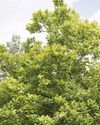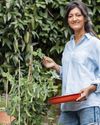
With the nights long and the days short right now it might feel like the propagation season has long since passed - but that's not the case for hardwood cuttings. Species such as cornus, buddleia and sambucus can be taken as cuttings from late autumn until late winter. They're super-easy and arguably have the highest success rate of any type of propagation.
My advice here focuses on standard hardwood cuttings, which are usually 30-40cm, long. But a few plants such as willow and poplar can be taken using the same method. Cuttings from these two trees can be up to two metres long and will root over winter to grow away in spring.
Step by step guide
Starting new shrubs from long, woody stems is easy and requires no specialised propagation kit: all you'll need is a sharp pair of secateurs and - if you are using containers - compost and pots
1 Choose stems from a healthy tree or shrub, ideally from vertical rather than horizontal growth in the upper part of the plant, as in this example of a cornus stem. Pick stems around the thickness of a pencil and aim for a length of between 30cm and 1m. If you are not planning to use the cutting material immediately, simply bury the bottom third in some soil until you're ready.
2 Get your cuttings ready by pruning them to 30-40cm in length. Make a horizontal cut 5mm below a leaf bud. Then make a second cut, this time at an angle, 30-40cm above the horizontal cut, as shown on these buddleia stems. This angled cut at the top will ensure you don’t accidentally plant the cuttings upside-down; also, it helps water drain off once they are planted.
Esta historia es de la edición December 2023 de BBC Gardeners World.
Comience su prueba gratuita de Magzter GOLD de 7 días para acceder a miles de historias premium seleccionadas y a más de 9,000 revistas y periódicos.
Ya eres suscriptor ? Conectar
Esta historia es de la edición December 2023 de BBC Gardeners World.
Comience su prueba gratuita de Magzter GOLD de 7 días para acceder a miles de historias premium seleccionadas y a más de 9,000 revistas y periódicos.
Ya eres suscriptor? Conectar

A new plot for tasty crops
Taking on a new allotment needn't be hard work. By simply following a few easy tips you can have bumper crops in no time, just like Alessandro Vitale

We love July
July is an island floating between the joy of June and the slightly fatigued month of August. It's a grown-up month: the year has shrugged off its adolescent exuberances, the weather is (hopefully) warm enough for ice cream to be one of your five a day, the sea should be swimmable without (too much) danger of hypothermia and thoughts will be of holiday shenanigans and family barbecues. School's out this month, the next tranche of glorious summer colour is washing across our borders and it's my birthday. Lots of reasons to give three rousing cheers for July!

YOUR PRUNING MONTH
Now, at the height of summer, Frances Tophill shows how to boost your plants' health and productivity with a timely cut

Hassle-free harvests
Flowers are out in abundance this month and for Jack Wallington, many of these blooms make delicious, low-effort pickings

Bite-sized bounties
Glorious doorstep harvests can easily turn into gluts, so let Rukmini Iyer's recipes help you savour every last bit

Upcycled outdoor living
Create unique and stylish garden features for minimal cost using reclaimed materials and simple DIY skills. Helen Riches shares four step-by-step projects and more inspiring eco tips

Secrets of a COLOURFUL GARDEN
Buildings and landscapes can play a vital role in supercharging your space, as Nick Bailey demonstrates

Greening up a city balcony
Looking for sustainable, small-space gardening ideas? Take inspiration from Oliver Hymans' transformed balcony garden in north-east London - now a lush, green haven for humans and wildlife

The dry and mighty garden
As we adapt our gardens to a more volatile climate, Alan Titchmarsh reveals how to create a drought-tolerant plot and picks his top plant performers

Nature knows best
Carol Klein explains how to choose plants for specific growing conditions, based on what has naturally adapted to thrive there